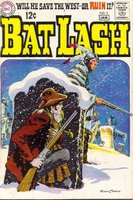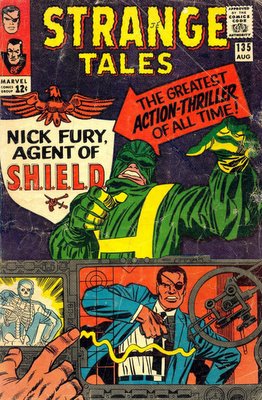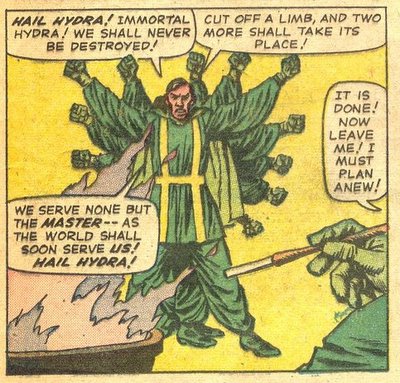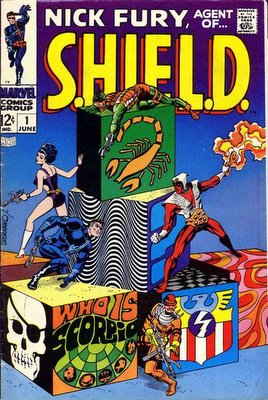
The secret agent boom in the 1960s was huge, propelled largely by the James Bond movies. TV responded with shows like Secret Agent, the Avengers, I Spy and the Man from UNCLE. The theme song to the first became a big hit for Johnny Rivers:
The comics were not far behind. Marvel came up with Nick Fury, Agent of SHIELD. Fury was Marvel's World War II Sergeant, upgraded to Lt. Colonel and updated to the 1960s, and improbably placed in charge of SHIELD despite his fairly low officer's rank. And although he was the head of the organization, he also acted as its main field man.
The series was initially scripted by Stan Lee and drawn by Jack Kirby as a co-feature with Dr. Strange in Strange Tales. Effective with #151, Jim Steranko was assigned to do the pencils, initially based on Jack Kirby's layouts. He quickly graduated to doing his own design, and eventually wrote the scripts as well. I believe that he was the first artist on a major Marvel series to handle both chores officially, although of course Kirby often provided suggested dialogue for Lee.
Steranko brought something new to the effort. He was clearly inspired by the psychedelic and op/pop art of the times. These comics stood out on the spinner rack. The artwork is breathtaking in places:



The story is complex, and was certainly confusing to me as a 13-year old back in 1968. Nick Fury is testing a weapons protection system in the desert near Las Vegas. He is about to be hit by a very strong bomb (yep, he's also SHIELD's chief guinea pig), when he realizes that the system has been turned off. He activates a rocket sled which takes him out of range just as the missile explodes.
When he gets to the SHIELD building in Las Vegas, he learns that Scorpio, an unidentified villain who apparently holds a grudge against Fury of long standing, has gassed the occupants and turned off the defense system.
A subplot involves a failed comedian named Flip Mason, who has just gambled away his last cash and already owes plenty to the mob. Just as he's about to attempt a holdup, he apparently gets lucky. A mobster confuses him for Mitch Hackett (another crook) and hands him a briefcase, telling the comic that it contains $200,000. When the real Hackett shows up, he and the mobster engage in a gun duel, just as Scorpio is escaping in a helicopter after battling Fury. As Hackett lies dying, he squeezes off one last round, which hits Scorpio's copter, resulting in the crash and explosion.
And Flip Mason? Does he now get back to his wife and infant son with the cash that will put them on easy street? Nope, for it turns out that the mobster was already planning on double-crossing Hackett, and had put a bomb in the briefcase instead of the money. As Mason dials San Francisco to tell his wife that they're rich, it explodes, leading to that last panel shown above.
Comments: A terrific tale, innovatively illustrated by Steranko. About the only negative I can find with the artwork is that the standard panels which serve to move the story forward seem ordinary and dull by comparison. The story reads like an extended Spirit tale by Eisner. I do suspect it was beyond the understanding of even adolescents; as I said above I was quite confused. Part of the problem is that Mason and Hackett both bear a strong resemblance to longtime SHIELD character Jasper Sitwell:

Although Sitwell had moved over to become a sidekick in the Iron Man series by then, anybody who read the back issues of Strange Tales (as I had) would probably assume that somehow he was involved here, and be waiting for the explanation which never came.
NFAS lasted 15 issues before being canceled in late 1969. I suspect that Marvel overestimated the market for such a sophisticated comic; although older readers did buy comics back then, as a percentage of their age cohort they were tiny compared to the boys and adolescents who made up the bulk of comic buyers. In addition, the comic ran into the brief but sharp 1969 recession and the end of the secret agent fad.
This comic foreshadows much of the 1970s as Marvel and DC pursued the boomer market, often at the expense of the youngsters who came behind them.














